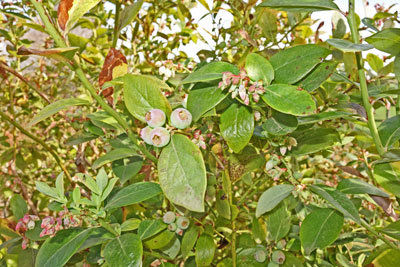
Blueberries: the wonder food. Each morsel is a powerhouse of nutrition and antioxidants.
Kids and adults alike love them fresh off the plant, on cereal and in desserts. And blueberry plants are beautiful in the garden.
I often design these highly ornamental shrubs into a garden to provide edibles in the landscape that serve both as a fun food to nibble as you walk in the garden and as a colorful accent in the fall when the foliage turns fiery red, orange and yellow.
Under the branches of a large shade tree at University of California, Santa Cruz Farm and Garden, I met with fellow blueberry enthusiasts for a recent workshop to learn from the experts how to grow blueberries in the home garden.
Liz Milazzo, field production manager, shared her personal top eight varieties.
She also told us how to choose varieties for different locales and growing conditions and how to select an appropriate planting location, prepare the planting hole or container, create soil conditions that blueberries need to thrive, prune them correctly and keep plants productive.
UCSC’s Farm and Garden grows a tenth of an acre of different kinds of blueberries. As we walked between the rows of plants for the pruning demonstration, I noticed many of them still had leaves and almost ripened blueberries.
Liz explained that these berries were set in November, and although they are ripening slowly, their taste will be inferior to summer berries. The best-tasting berries come from flowers set in March.
You can choose early and late-ripening blueberry varieties to extend your harvest.
Berry size and overall yield are more important to commercial growers, as are varieties that set in clusters, making it easier for them to harvest.
For the home gardener, taste is what we are looking for, and it’s easy to pick a berry here and another there as they ripen to perfection.
So, what are the top picks of the farm manager? Drum roll, please.
Her No. 1 pick for the Santa Cruz area is Southmoon. This variety produces early-, mid- and late-season fruit and is a nice blend of acid and sweet.
Coming in at No. 2 is Jubilee, an upright shrub with sky-blue berries.
Liz also likes other southern high-bush varieties, such as O’Neill, Santa Fe, Sapphire, Windsor, Jewel and Misty.
Some of these are tall woody plants, while others are more spreading.
For containers, a tall variety, such as Windsor or Jewel, would not work as well as a medium-sized bush with an arching form, such as Misty, Southmoon or Jubilee.
Blueberries need six hours of sun or more, regular watering and lots of mulch over their roots. They naturally grow in bogs.
The year before the Farm planted its blueberry field, the pH of the soil was 6. Blueberries prefer more acidic conditions, so after having their soil tested, they tilled in redwood mulch and soil sulfur at the recommended rate.
Striving to keep the soil at 4.5 to 5.5 pH, the Farm team renews the mulch yearly in the fall and adds vinegar to the water each time it is irrigated to acidify the soil.
The farm uses commercial-grade vinegar, but the home gardener can use inexpensive white vinegar at a rate of one tablespoon per gallon of water. Liz explained that this will bring city water down to a pH of 5 and blueberries love it.
The Farm irrigates the blueberries two or three times per week with half-gallon-per-hour emitters on a drip line spaced 12 inches apart. Each plant gets two or three emitters.
Blueberries require acidic soil rich in organic matter, and an easy way to supply this is to buy ready-made organic soil for rhododendrons and camellias to use in containers or to amend native soil 50 percent.
Renewable and sustainable soil amendments include cottonseed meal, feather meal and mustard meal, which comes from crushed mustard seed. Pescadero Gold, available at Mountain Feed in Ben Lomond, is a good source of mustard meal.
A three- to four-inch layer of mulch over the roots is especially important, as blueberries have shallow roots close to the surface of the soil. They don’t have root hairs as other plants do, so they depend on mycorrhizal fungi to absorb nutrients. Protect this active zone with a mulch of organic woody material such as wood chips, redwood compost, clean sawdust, pine bark or pine or redwood needles.
Blueberries deserve a little extra attention to their growing conditions. They repay you with scrumptious, nutritious berries.
– Jan Nelson, a landscape designer and California certified nursery professional, will answer questions about gardening in the Santa Cruz Mountains. Email her at ja******@*ol.com, or visit www.jannelsonlandscapedesign.com to view past columns and pictures.












